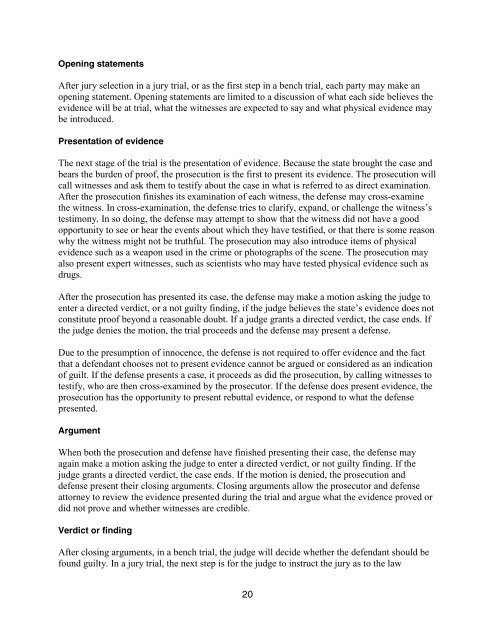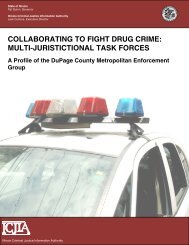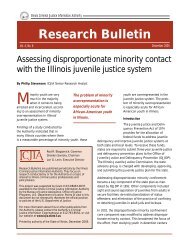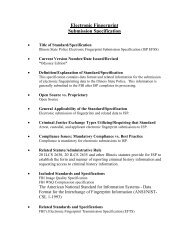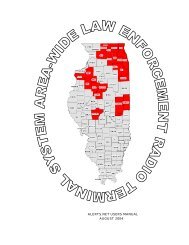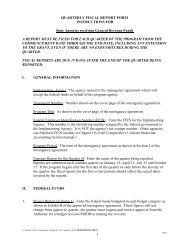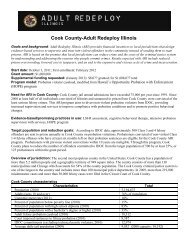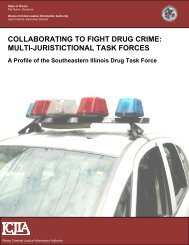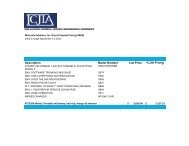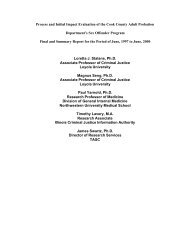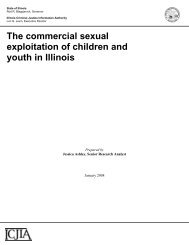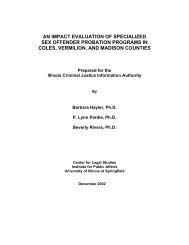policies and procedures of the illinois criminal justice system
policies and procedures of the illinois criminal justice system
policies and procedures of the illinois criminal justice system
Create successful ePaper yourself
Turn your PDF publications into a flip-book with our unique Google optimized e-Paper software.
Opening statements<br />
After jury selection in a jury trial, or as <strong>the</strong> first step in a bench trial, each party may make an<br />
opening statement. Opening statements are limited to a discussion <strong>of</strong> what each side believes <strong>the</strong><br />
evidence will be at trial, what <strong>the</strong> witnesses are expected to say <strong>and</strong> what physical evidence may<br />
be introduced.<br />
Presentation <strong>of</strong> evidence<br />
The next stage <strong>of</strong> <strong>the</strong> trial is <strong>the</strong> presentation <strong>of</strong> evidence. Because <strong>the</strong> state brought <strong>the</strong> case <strong>and</strong><br />
bears <strong>the</strong> burden <strong>of</strong> pro<strong>of</strong>, <strong>the</strong> prosecution is <strong>the</strong> first to present its evidence. The prosecution will<br />
call witnesses <strong>and</strong> ask <strong>the</strong>m to testify about <strong>the</strong> case in what is referred to as direct examination.<br />
After <strong>the</strong> prosecution finishes its examination <strong>of</strong> each witness, <strong>the</strong> defense may cross-examine<br />
<strong>the</strong> witness. In cross-examination, <strong>the</strong> defense tries to clarify, exp<strong>and</strong>, or challenge <strong>the</strong> witness’s<br />
testimony. In so doing, <strong>the</strong> defense may attempt to show that <strong>the</strong> witness did not have a good<br />
opportunity to see or hear <strong>the</strong> events about which <strong>the</strong>y have testified, or that <strong>the</strong>re is some reason<br />
why <strong>the</strong> witness might not be truthful. The prosecution may also introduce items <strong>of</strong> physical<br />
evidence such as a weapon used in <strong>the</strong> crime or photographs <strong>of</strong> <strong>the</strong> scene. The prosecution may<br />
also present expert witnesses, such as scientists who may have tested physical evidence such as<br />
drugs.<br />
After <strong>the</strong> prosecution has presented its case, <strong>the</strong> defense may make a motion asking <strong>the</strong> judge to<br />
enter a directed verdict, or a not guilty finding, if <strong>the</strong> judge believes <strong>the</strong> state’s evidence does not<br />
constitute pro<strong>of</strong> beyond a reasonable doubt. If a judge grants a directed verdict, <strong>the</strong> case ends. If<br />
<strong>the</strong> judge denies <strong>the</strong> motion, <strong>the</strong> trial proceeds <strong>and</strong> <strong>the</strong> defense may present a defense.<br />
Due to <strong>the</strong> presumption <strong>of</strong> innocence, <strong>the</strong> defense is not required to <strong>of</strong>fer evidence <strong>and</strong> <strong>the</strong> fact<br />
that a defendant chooses not to present evidence cannot be argued or considered as an indication<br />
<strong>of</strong> guilt. If <strong>the</strong> defense presents a case, it proceeds as did <strong>the</strong> prosecution, by calling witnesses to<br />
testify, who are <strong>the</strong>n cross-examined by <strong>the</strong> prosecutor. If <strong>the</strong> defense does present evidence, <strong>the</strong><br />
prosecution has <strong>the</strong> opportunity to present rebuttal evidence, or respond to what <strong>the</strong> defense<br />
presented.<br />
Argument<br />
When both <strong>the</strong> prosecution <strong>and</strong> defense have finished presenting <strong>the</strong>ir case, <strong>the</strong> defense may<br />
again make a motion asking <strong>the</strong> judge to enter a directed verdict, or not guilty finding. If <strong>the</strong><br />
judge grants a directed verdict, <strong>the</strong> case ends. If <strong>the</strong> motion is denied, <strong>the</strong> prosecution <strong>and</strong><br />
defense present <strong>the</strong>ir closing arguments. Closing arguments allow <strong>the</strong> prosecutor <strong>and</strong> defense<br />
attorney to review <strong>the</strong> evidence presented during <strong>the</strong> trial <strong>and</strong> argue what <strong>the</strong> evidence proved or<br />
did not prove <strong>and</strong> whe<strong>the</strong>r witnesses are credible.<br />
Verdict or finding<br />
After closing arguments, in a bench trial, <strong>the</strong> judge will decide whe<strong>the</strong>r <strong>the</strong> defendant should be<br />
found guilty. In a jury trial, <strong>the</strong> next step is for <strong>the</strong> judge to instruct <strong>the</strong> jury as to <strong>the</strong> law<br />
20


